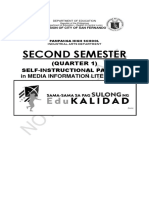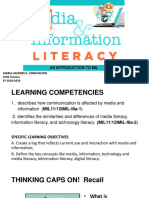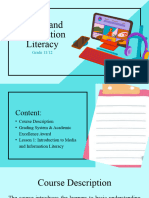Q1 W1 Introduction To Media and Information Literacy
Q1 W1 Introduction To Media and Information Literacy
Uploaded by
Greg AlvarezCopyright:
Available Formats
Q1 W1 Introduction To Media and Information Literacy
Q1 W1 Introduction To Media and Information Literacy
Uploaded by
Greg AlvarezOriginal Title
Copyright
Available Formats
Share this document
Did you find this document useful?
Is this content inappropriate?
Copyright:
Available Formats
Q1 W1 Introduction To Media and Information Literacy
Q1 W1 Introduction To Media and Information Literacy
Uploaded by
Greg AlvarezCopyright:
Available Formats
Senior High School
Dumaguete City National High School
Senior High School
Media and Information Literacy
First Semester, First Quarter SY 2021-2022
Module 1:
Introduction to Media and Information Literacy
Adapted from Media and Information Literacy Module, by Mary Antoinette M.
Magallanes, DepEd Bureau of Learning Resources (DepEd-BLR)
Learning Competencies
• Describes how much media and information affect communication.
MIL11/12IMILIIIa-1
• Identifies the similarities and differences of media literacy, information literacy, and
technology literacy.
MIL11/12IMILIIIa-2
Mr. Gregorio B. Alvarez Jr.
Subject Teacher
Module 1:
Introduction to Media and Information Literacy
Content Standards
The learner demonstrates an understanding of media and information sources, and values
them as part of communication tools.
Performance Standards
The learners shall be able to create a log of their use and interaction with media and
information providers to aid in their understanding of media and information literacy.
What I Need to Know
At the end of the module, you must able to:
describe the nature of communication and the concepts related to it;
describe how communication is affected by media and information (MIL11/12IMIL-IIIa-
1); and
What I Know
Directions: Complete the statements below using your OWN THOUGHTS.
1. Media refers to ____________________________________________________________
_____________________________________________________________________________
2, Information refers to _______________________________________________________
3. Literacy refers to ___________________________________________________________
4. What do you expect to learn in our subject? What will you do to learn these things?
Communication - the act or process of using words, sounds, signs, or behaviors
to express or exchange information or to express your ideas, thoughts, feelings,
etc., to someone else (http://www.merriam-webster.com)
• the exchange of information and the expression of feeling that can result
in understanding (http://dictionary.cambridge.org)
Activity 1: What’s New
Directions: From the photo at the left,
identify the following:
1. Who is the Sender?
___________________
2. What is the Message?
__________________________
3. What is the Medium/Channel used?
__________________________
4. Who is/are the Receiver/s?
__________________________
Media and Information
The term ‘Media’ could today be defined as a collective term for television,
radio, cinema and the press. The media are nowadays often discussed as a
single entity, because of their combined importance as providers of
entertainment and information, their presumed power to mould public opinion
and set standards and the growth of cross-ownership among the various sectors.
The word was however, originally derived from (i.e. is the plural of) the word
‘medium’, which suggested a medium for the transfer of information.
Media are channels through which information is transmitted or through which
communication takes place. In a similar way, ‘Information Technology’ could
be described as a term commonly used to cover the range of technologies
relevant to the transfer of information, in particular to computers, digital
electronics and telecommunications.
Activity 2: Imagine!
Imagine waking up one day to find no internet, libraries, and cell phones.
Newspapers, magazines, radio stations and TV channels have also
disappeared.
• How would you be informed of anything now?
• What ways would you have to communicate with one another?
• How would you share information and communicate news and events?
• What would happen with the decisions you usually make?
• How would it affect the way you live?
• What would you personally miss most in such a situation?
•What would society lose in this situation?
Media – communication tools
Information – data, knowledge
derived from study, experience, or
instruction, signals, or symbols
-knowledge of specific events or
situations
Retrieved from: https://www.google.com/search?q=what+is+media&tbm=isch&ved=2ahUKEwjIvPCO54brAhWDwIsBHQvxCyoQ2-
cCegQIABAA&oq=what+is+media&gs_lcp=CgNpbWcQAzICCAAyAggAMgIIADICCAAyAggAMgIIADICCAAyAggAMgIIADICCAA6BQgAELEDOggIABCxAxCDAToECAAQQzoE
CAAQA1DPrApYs7kKYLm7CmgAcAB4AIAByAKIAZoQkgEHMC45LjIuMZgBAKABAaoBC2d3cy13aXotaW1nwAEB&sclient=img&ei=8hUsX8h7g4GvvA-
L4q_QAg&bih=675&biw=1517#imgrc=_l_jKwTVOy0jjM
• Literacy: The ability to identify, understand, interpret, create, communicate
and compute, using printed and written materials associated with varying
contexts.
• Media: The physical objects used to communicate with, or the mass
communication through physical objects such as radio, television, computers,
film, etc. It also refers to any physical object used to communicate messages.
• Media Literacy: The ability to access, analyze, evaluate, and create media in
a variety of forms. It aims to empower citizens by providing them with the
competencies (knowledge and skills) necessary to engage with traditional
media and new technologies.
• Information: A broad term that covers processed data, knowledge derived
from study, experience, instruction, signals or symbols.
• Information Literacy: The ability to recognize when information is needed, and
to locate, evaluate, and effectively communicate information in its various
formats.
• Technology Literacy: The ability of an individual, either working independently
or with others, to responsibly, appropriately, and effectively use technological
tools.
• Media and Information Literacy: The essential skills and competencies that
allow individuals to engage with media and other information providers
effectively, as well as develop critical thinking and life-long learning skills to
socialize and become active citizens.
Performance Output: Poster-Making
Directions: Create a poster on a 1/8 illustration board or similar material that
shows how media can be a tool for communication. It should also show how
media affected or changed the way we communicate with other people.
Rubrics:
Design/Presentation – The poster is exceptionally attractive in terms of neatness,
has a brief explanation at the back, well-drawn and not messy, easy to
understand. (20 points)
Originality – Poster is exceptionally the result of the student’s original
imagination. (20 points)
Creativity – Poster is exceptionally creative and a lot of thought and effort was
used. (10 points)
Assessment
Directions: MODIFIED TRUE OR FALSE. Write TRUE if the statement is correct. If the statement is
false, write FALSE and write the word/phrase to correct the statement.
________1. Media Literacy refers to the ability to access, analyze, evaluate, and create
media in a variety of forms. It aims to empower citizens by providing them with the
competencies (knowledge and skills) necessary to engage with traditional media and new
technologies.
_______2. Technology Literacy is the ability of an individual, either working independently or
with others, to responsibly, appropriately, and effectively use technological tools.
_______3. Information refers to the data, knowledge derived from study, experience, or
instruction, signals, or symbols.
_______4. Literacy is a broad term that covers processed data, knowledge derived from study,
experience, instruction, signals or symbols.
_______5. Technology refers to the physical objects used to communicate with, or the mass
communication through physical objects such as radio, television, computers, film, etc. It also
refers to any physical object used to communicate messages.
References:
Communication Models. (n.d.). Retrieved August 07, 2020, from
http://communicationtheory.org/category/communication-models/page/2/
Irvine, M. (n.d.). Retrieved August 07, 2020, from
http://faculty.georgetown.edu/irvinem/CCTP748/Carey-summary-comm-culture.html
K to 12 BASIC EDUCATION CURRICULUM SENIOR HIGH SCHOOL CORE ... (n.d.). Retrieved
August 2020, from https://www.deped.gov.ph/wp-content/uploads/2019/01/SHS-
Core_Media-and-Information-Literacy-CG.pdf
Martin, J. (2007). Audiences and Reception Theory. Retrieved from
http://www.sociologymadesimple.com/papers/
Media and Information Literacy (Mil). (n.d.). Retrieved August 2020, from
https://www.scribd.com/presentation/412466978/Media-and-Information-Literacy-Mil
Wilson, C., Grizzle, A., Tuazon, R., Akyempong, K., & Cheung, C. (2011). Media and Information
Literacy Curriculum for Teachers: United Nations Educational, Scientific and Cultural
Organization. Retrieved August 2020, from
http://www.unesco.org/new/en/communication-and-
information/resources/publications-and-communication-materials/publications/full-
list/media-and-information-literacy-curriculum-for-teachers/
You might also like
- Tubi - Brand-Book - 171026 2 PDFDocument46 pagesTubi - Brand-Book - 171026 2 PDFÁlvaro Matías Göede RiveraNo ratings yet
- Media and Information Literacy: Quarter 3 Module 1Document35 pagesMedia and Information Literacy: Quarter 3 Module 1girlie paraiso80% (5)
- Media and Information Literacy: Quarter 4 - Module 1Document28 pagesMedia and Information Literacy: Quarter 4 - Module 1Randy Reyes40% (5)
- Build A CMS in An Afternoon With PHP and MySQLDocument45 pagesBuild A CMS in An Afternoon With PHP and MySQLhnguyen_698971No ratings yet
- Schneider Electric - Foxboro Evo SCD6000 Installation GuideDocument60 pagesSchneider Electric - Foxboro Evo SCD6000 Installation GuideMuhd Nu'man H100% (2)
- MIL Quarter 3 FinalDocument39 pagesMIL Quarter 3 FinalRoan Diraco100% (2)
- Mil Met1 SLM PDFDocument5 pagesMil Met1 SLM PDFLielanie NavarroNo ratings yet
- Introduction To Media and Information LiteracyDocument13 pagesIntroduction To Media and Information LiteracyJoiemmy Sumedca Bawengan GayudanNo ratings yet
- Media and Information Literacy (Module) : Saver'S Technological College of Davao, IncDocument45 pagesMedia and Information Literacy (Module) : Saver'S Technological College of Davao, IncLeah L. AlposNo ratings yet
- MIL Week 1 &2Document19 pagesMIL Week 1 &2MARY ANN PANGANNo ratings yet
- 1 12 Module in Mil 11 Quarter 1 Melc 2, FinalDocument10 pages1 12 Module in Mil 11 Quarter 1 Melc 2, Finaljenny feNo ratings yet
- MED INFO Lesson 1 NotesDocument3 pagesMED INFO Lesson 1 NotesLOREEN BERNICE LACSONNo ratings yet
- Module 1 MILDocument7 pagesModule 1 MILJan Maurile AguaNo ratings yet
- Questions MilDocument4 pagesQuestions MilAdrianne Chavez BasiNo ratings yet
- Q1 W2 Media Literacy Information Literacy and Technology LiteracyDocument5 pagesQ1 W2 Media Literacy Information Literacy and Technology LiteracyJunrey Belando100% (1)
- An Introduction To Mil: Maria Lourdes G. Coronacion LSHS Teacher SY 2018-2019Document28 pagesAn Introduction To Mil: Maria Lourdes G. Coronacion LSHS Teacher SY 2018-2019petor fiegelNo ratings yet
- StudentDocument7 pagesStudentapi-326480150No ratings yet
- SLG1 MIL MidtermDocument7 pagesSLG1 MIL MidtermLordave OtsuguaNo ratings yet
- Mil Module 2Document9 pagesMil Module 2Maria ArleneNo ratings yet
- CORE MILQ1 Mod2 W2 Similarities-and-DifferencesDocument19 pagesCORE MILQ1 Mod2 W2 Similarities-and-DifferencesmicheljohnbatulanNo ratings yet
- Media and Information Literacy Grade 12 - Q1 Week 1Document9 pagesMedia and Information Literacy Grade 12 - Q1 Week 1Nuur Em100% (1)
- Media Literacy, Information Literacy, and Technology LiteracyDocument9 pagesMedia Literacy, Information Literacy, and Technology LiteracyRenalyn Rose MandiqueNo ratings yet
- 2nd TopicDocument19 pages2nd TopicJusua Martinez NatabioNo ratings yet
- Interactive FOR Media Information LiteracyDocument6 pagesInteractive FOR Media Information LiteracyJoel Cabusao Lacay100% (1)
- Final Mil DoneDocument55 pagesFinal Mil DoneMariel Yeng Suing100% (1)
- Mil 1Document11 pagesMil 1BRENDEL SACARIS100% (1)
- SHS - Media Information Literacy - Q1 - Wk1 - Day3Document3 pagesSHS - Media Information Literacy - Q1 - Wk1 - Day3Janice Fuerzas Balmera CuragNo ratings yet
- MIL - Module 2Document9 pagesMIL - Module 2France PotterNo ratings yet
- LESSON 1 Introduction To Media and Informartion LiteracyDocument22 pagesLESSON 1 Introduction To Media and Informartion LiteracyDarius Dave CruzNo ratings yet
- MIL - INTRODUCTION-Feb21-25, 2022Document23 pagesMIL - INTRODUCTION-Feb21-25, 2022Everdina GiltendezNo ratings yet
- Mil Q2 Module2-FinalDocument18 pagesMil Q2 Module2-FinalJethroel Am-is100% (2)
- MIL LAS Q3 Wk5 MELC5Document7 pagesMIL LAS Q3 Wk5 MELC5Edmar BarridoNo ratings yet
- Media and Information Literacy - G11: Quarter 3 - Week 1Document8 pagesMedia and Information Literacy - G11: Quarter 3 - Week 1wiz wizNo ratings yet
- Quarter 1 Module 2: Media Literacy, Information Literacy and Technology LiteracyDocument9 pagesQuarter 1 Module 2: Media Literacy, Information Literacy and Technology LiteracyrandylyncabatuanNo ratings yet
- Media and Information Literacy: First Quarter/ Week 1 / Day 1Document5 pagesMedia and Information Literacy: First Quarter/ Week 1 / Day 1Baems Ambor100% (1)
- Mil Q3 - Week 2 Module 2 PDFDocument12 pagesMil Q3 - Week 2 Module 2 PDFJelai MedinaNo ratings yet
- MIL WK 1Document16 pagesMIL WK 1Mebet MoralesNo ratings yet
- Mil 1ST Sem 2ND Quarter Week 1Document8 pagesMil 1ST Sem 2ND Quarter Week 1Vincent L. SantiagoNo ratings yet
- MIL Activity Sheets 1st QRT WK 1Document15 pagesMIL Activity Sheets 1st QRT WK 1Albert LorenzoNo ratings yet
- MIL Week1 Information-SheetDocument12 pagesMIL Week1 Information-SheetPrince Adrian RelojNo ratings yet
- Current and Future Trends of Media and InformationDocument4 pagesCurrent and Future Trends of Media and InformationCyril Argie LequinNo ratings yet
- Media and Information Literacy - G11: Quarter 3 - Week 2Document8 pagesMedia and Information Literacy - G11: Quarter 3 - Week 2wiz wizNo ratings yet
- Mil Module 1 - Introduction To Media and Information Literacy 2021Document14 pagesMil Module 1 - Introduction To Media and Information Literacy 2021Imie Omamalin GuisehanNo ratings yet
- Prepared By: Maria Jenilli M. Quintanilla, LPTDocument22 pagesPrepared By: Maria Jenilli M. Quintanilla, LPTsuleman019No ratings yet
- MIL Q1 Lesson 2 Intro To Media and Information LiteracyDocument98 pagesMIL Q1 Lesson 2 Intro To Media and Information LiteracysanjiecuteNo ratings yet
- LM SHS MIT L1 - ScribdDocument7 pagesLM SHS MIT L1 - ScribdVer Dnad Jacobe100% (1)
- Media and Information Technology: Department of EducationDocument16 pagesMedia and Information Technology: Department of EducationMatt Gabriel LacierdaNo ratings yet
- Q2 Mil Adm Module Grade 12Document33 pagesQ2 Mil Adm Module Grade 12Rafael CurtesNo ratings yet
- Lesson 1 - Study Guide MilDocument8 pagesLesson 1 - Study Guide MilKyla Renz de LeonNo ratings yet
- Media LiteracyDocument17 pagesMedia LiteracyEmjee BermoyNo ratings yet
- Media and Information LiteracyDocument32 pagesMedia and Information LiteracyMyke RullanNo ratings yet
- MIL 2nd Week ExemplarDocument6 pagesMIL 2nd Week ExemplarRickely BantaNo ratings yet
- Module 5 Media Literacy PDFDocument18 pagesModule 5 Media Literacy PDFSheena Glen ValdenibroNo ratings yet
- Activity 1 PrefinalDocument5 pagesActivity 1 PrefinalLynnah SibongaNo ratings yet
- Cor 016 - 1ST Periodical Test Reviewers Day 11 16Document6 pagesCor 016 - 1ST Periodical Test Reviewers Day 11 16Lorenz TalaoNo ratings yet
- Assignment 1 MIL BadionDocument2 pagesAssignment 1 MIL BadionAnthonyalennNo ratings yet
- SHS Lesson 1Document31 pagesSHS Lesson 1Lilian Rose de LaraNo ratings yet
- TTLS - Digital Literacy SkillsDocument33 pagesTTLS - Digital Literacy SkillsZerah LunaNo ratings yet
- Q1 W2 Media Literacy Information Literacy and Technology LiteracyDocument5 pagesQ1 W2 Media Literacy Information Literacy and Technology LiteracyGreg Alvarez100% (1)
- Week 3 Media and Information LiteracyDocument13 pagesWeek 3 Media and Information Literacymaxene jadeNo ratings yet
- LM Ict Computer 10 3rd Q 1Document21 pagesLM Ict Computer 10 3rd Q 1artemio061108No ratings yet
- English: Evolution of MediaDocument12 pagesEnglish: Evolution of MediaJuren Andrew Nieves100% (2)
- Media Literacy for Young Children: Teaching Beyond the Screen Time DebatesFrom EverandMedia Literacy for Young Children: Teaching Beyond the Screen Time DebatesNo ratings yet
- Q1 W2 Media Literacy Information Literacy and Technology LiteracyDocument5 pagesQ1 W2 Media Literacy Information Literacy and Technology LiteracyGreg Alvarez100% (1)
- Career Pathways in Technology and Livelihood Education (Tle)Document15 pagesCareer Pathways in Technology and Livelihood Education (Tle)Greg AlvarezNo ratings yet
- Answers: Ad + BCDocument1 pageAnswers: Ad + BCGreg AlvarezNo ratings yet
- Mathinvestigatoryproject2015 180131233159 PDFDocument21 pagesMathinvestigatoryproject2015 180131233159 PDFGreg AlvarezNo ratings yet
- Computer Repair: Build. Configure. TroubleshootDocument14 pagesComputer Repair: Build. Configure. TroubleshootGreg AlvarezNo ratings yet
- Math 10 Worksheets PDFDocument213 pagesMath 10 Worksheets PDFGreg AlvarezNo ratings yet
- Grade 10 Area Related To Circles: Choose Correct Answer(s) From The Given ChoicesDocument3 pagesGrade 10 Area Related To Circles: Choose Correct Answer(s) From The Given ChoicesGreg AlvarezNo ratings yet
- Math 10 Worksheets PDFDocument213 pagesMath 10 Worksheets PDFGreg AlvarezNo ratings yet
- CBLM CSS Coc 1Document119 pagesCBLM CSS Coc 1Greg Alvarez0% (1)
- 2.02 Remember The Rules of Online SafetyDocument7 pages2.02 Remember The Rules of Online SafetyGreg AlvarezNo ratings yet
- E-Safety & Becoming Digital Citizens': Parent Workshop 19 November 2014Document25 pagesE-Safety & Becoming Digital Citizens': Parent Workshop 19 November 2014Greg AlvarezNo ratings yet
- Mathematics 8 Third Periodic Test Table of Specification: Guinayangan National High School Guinayangan, QuezonDocument1 pageMathematics 8 Third Periodic Test Table of Specification: Guinayangan National High School Guinayangan, QuezonGreg AlvarezNo ratings yet
- GRADES 1 To 12 Daily Lesson LOG DateDocument3 pagesGRADES 1 To 12 Daily Lesson LOG DateGreg Alvarez100% (1)
- List of Tools and Materials/Inventory (Written) :: 3. Assemble System Unit (Manual)Document23 pagesList of Tools and Materials/Inventory (Written) :: 3. Assemble System Unit (Manual)Greg AlvarezNo ratings yet
- QOS Management Protocol For Mobile Ad Hoc Networks Using Mobile Agents - SpringerLinkDocument9 pagesQOS Management Protocol For Mobile Ad Hoc Networks Using Mobile Agents - SpringerLinkDr. Mallikarjun B CNo ratings yet
- Record - Index PageDocument2 pagesRecord - Index Pageakshra TyagiNo ratings yet
- Subject: - Annual Verification & Stamping of CNG Dispensers at M/s-Coco Sahar, SaharDocument3 pagesSubject: - Annual Verification & Stamping of CNG Dispensers at M/s-Coco Sahar, SaharDevend HarinkhedeNo ratings yet
- 5039 ASM2-NguyenNLT GBD210645 GBD1009Document25 pages5039 ASM2-NguyenNLT GBD210645 GBD1009Nguyen Le Trang Nguyen (FGW DN)No ratings yet
- QR Code Generator & Scanner App2Document13 pagesQR Code Generator & Scanner App2Pratham Singh ParmarNo ratings yet
- WcnweocbwubDocument20 pagesWcnweocbwubSumit KumarNo ratings yet
- India's Wind SectorDocument5 pagesIndia's Wind Sectorakhil86No ratings yet
- Prima 465 Sales en 0822Document6 pagesPrima 465 Sales en 0822Didier Andrey Sanchez JimenezNo ratings yet
- SOC345 Chapter Summary 6Document4 pagesSOC345 Chapter Summary 6Jacov SmithNo ratings yet
- Get Ready For ISO 20022 Go-Live For Payments, and The Start of Coexistence, in November 2022Document1 pageGet Ready For ISO 20022 Go-Live For Payments, and The Start of Coexistence, in November 2022Lahari DeeviNo ratings yet
- Case v67Document342 pagesCase v67FantahunNo ratings yet
- Chatgpt 3.5 #DesignerDocument16 pagesChatgpt 3.5 #DesignerNitya JaniNo ratings yet
- Heart Disease Detection System Proposal - 2024Document28 pagesHeart Disease Detection System Proposal - 2024Hamid RiazNo ratings yet
- Drilling Log: Laboratorium Mekanika Tanah & BatuanDocument2 pagesDrilling Log: Laboratorium Mekanika Tanah & BatuanFelix LualdiNo ratings yet
- Fire Exit Railing DetailsDocument1 pageFire Exit Railing DetailsRenz ChuaNo ratings yet
- Pneumatic Structures: Nmam Institute of Technology, NitteDocument33 pagesPneumatic Structures: Nmam Institute of Technology, NittehaleshspNo ratings yet
- Longman +WB Sec 3Document50 pagesLongman +WB Sec 3Wagdy MohammedNo ratings yet
- 23 24 LP 21 ISC12 C12 Inheritance, Interface&polymorphismDocument61 pages23 24 LP 21 ISC12 C12 Inheritance, Interface&polymorphismpraveena k j kiranNo ratings yet
- Actros mp2 (HM)Document8 pagesActros mp2 (HM)Elvis OdangaNo ratings yet
- Embassies PakistanDocument11 pagesEmbassies Pakistanwolfk488No ratings yet
- RC-1 Course Out Line 2012ECDocument5 pagesRC-1 Course Out Line 2012ECRobel GeremewNo ratings yet
- Manuel AutoCad 2012Document1,698 pagesManuel AutoCad 2012sohaib houdaNo ratings yet
- Cannot Change The Status of Control Budget Control Budget From Not Ready For Use - Redefining PDFDocument2 pagesCannot Change The Status of Control Budget Control Budget From Not Ready For Use - Redefining PDFBhavikNo ratings yet
- ISTQB CTFL 2018v3.1 Sample Exam B Answers v1.4Document32 pagesISTQB CTFL 2018v3.1 Sample Exam B Answers v1.4Kseniia HavrylenkoNo ratings yet
- Final Certificate LDA LD 23-24-1827Document4 pagesFinal Certificate LDA LD 23-24-1827Shubham MishraNo ratings yet
- (4.1) Social Media Privacy Issues For 2020 - Threats & RisksDocument7 pages(4.1) Social Media Privacy Issues For 2020 - Threats & RisksIman NabeehaNo ratings yet
- IIM Visakhapatnam FT Brochure-V2Document29 pagesIIM Visakhapatnam FT Brochure-V2somuNo ratings yet





































































































